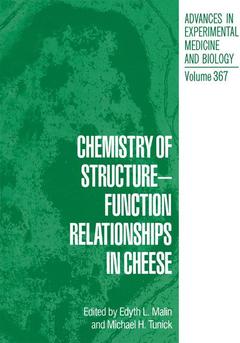Description
Chemistry of Structure-Function Relationships in Cheese, Softcover reprint of the original 1st ed. 1995
Advances in Experimental Medicine and Biology Series, Vol. 367
Coordinators: Malin Edyth L., Tunick Michael H.
Language: English
Subjects for Chemistry of Structure-Function Relationships in Cheese:
Keywords
Publication date: 10-2012
397 p. · 17.8x25.4 cm · Paperback
397 p. · 17.8x25.4 cm · Paperback
Description
/li>Contents
/li>
Although the art of making cheese can be traced to prehistoric times, it has continued to evolve as modern civilization progressed. The advent of new technologies and instrumentation has brought exponential growth in the understanding of cheese components and their function. Even more recently, the evolution of cheesemaking has accelerated, driven by economic factors such as the establishment of the European Economic Community, the changing diet of developed countries, and the environmental and economic concerns associated with whey disposal. Molecular biology has revolutionized the development of starter and adjunct cultures as well as rennets, and genetics will make it possible to maintain ideal milk components for cheesemaking. The ability to accelerate traditional ripening procedures has altered the production of certain cheeses, and the emphasis on decreasing the intake of dietary fat, especially in the United States, has prompted the development of technology for producing low-fat cheeses with traditional texture and flavor. In assembling a distinguished group of participants for the symposium, "Chemistry of the Structure/Function Relationships in Cheese," we hoped to review the interplay of these trends and forecast the direction of future research. Contributors evaluated the current status of cheesemaking and highlighted the information that will be essential for new developments. They also focused the attention of agricultural and food chemists on the opportunities in cheese research and the potential contributions they might make to the future of cheese, a most valuable food product. We are indebted to Dr. Patrick Fox, Dr. Mark Johnson, Dr. Milos Kalab, Dr.
Physical Chemistry of Cheese Texture.- 1. Overview: Cheese Chemistry and Rheology.- 2. Rheology of Reduced-Fat Mozzarella Cheese.- 3. Rheology of Reduced-Fat Cheese Containing Fat Substitute.- 4. Factors Affecting the Functional Characteristics of Unmelted and Melted Mozzarella Cheese.- Chemical Origins of Cheese Flavor.- 5. Chemical Species in Cheese and Their Origin in Milk Components.- 6. Biogenesis of Flavour Compounds in Cheese.- 7. Cheddar Cheese Flavour and Chemical Indices: Changes During Maturation.- 8. Assessment of Accelerated Cheese Ripening by Reverse-Phase HPLC.- 9. Time-Temperature Effects on Microbial, Chemical, and Sensory Changes During Cooling and Aging of Cheddar Cheese.- Proteolysis during Ripening.- 10. Methods for Assessing Proteolysis During Maturation.- 11. Contribution of Milk-Clotting Enzymes and Plasmin to Cheese Ripening.- 12. Contribution of Lactic Acid Bacteria to Cheese Ripening.- 13. Maturation Profiles of Cheddar-Type Cheese Produced from High Heat Treatment Milk to Incorporate Whey Protein.- 14. Inhibition of Proteolysis in Mozzarella Cheese Prepared from Homogenized Milk.- Molecular and Ultrastructure of Cheese.- 15. Practical Aspects of Electron Microscopy in Cheese Research.- 16. Immunolocalization and Microstructure of Milk Proteins and Fat Mimetics.- 17. Microstructure Studies of Reduced Fat Cheeses Containing Fat Substitute.- 18. Influence of Casein Peptide Conformations on Textural Properties of Cheese.- 19. Electron-Density Patterns in Low-Fat Mozzarella Cheeses During Refrigerated Storage.- 20. Applications of Confocal Microscopy to Fat Globule Structure in Cheese.- Technological and Nutritional Aspects of Reduced-Fat Cheese.- 21. Technology of Manufacturing Reduced-Fat Cheddar Cheese.- 22. Nutritional Aspects of Reduced-Fat Cheese.- 23. Microbiology and Biochemistry of Reduced-Fat Cheese.- 24. Whey Protein in Cheese — An Overview.- 25. Reduced-Fat Cheese: Regulations and Definitions.- 26. Improving the Sensory Characteristics of Reduced-Fat Cheese.- Contributors.
© 2024 LAVOISIER S.A.S.



